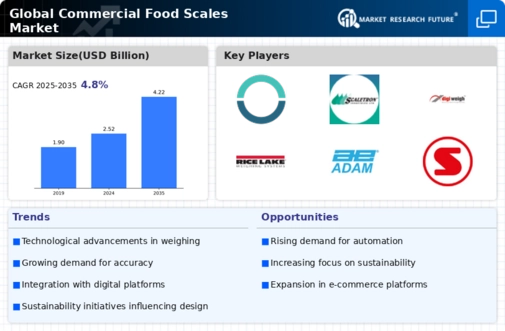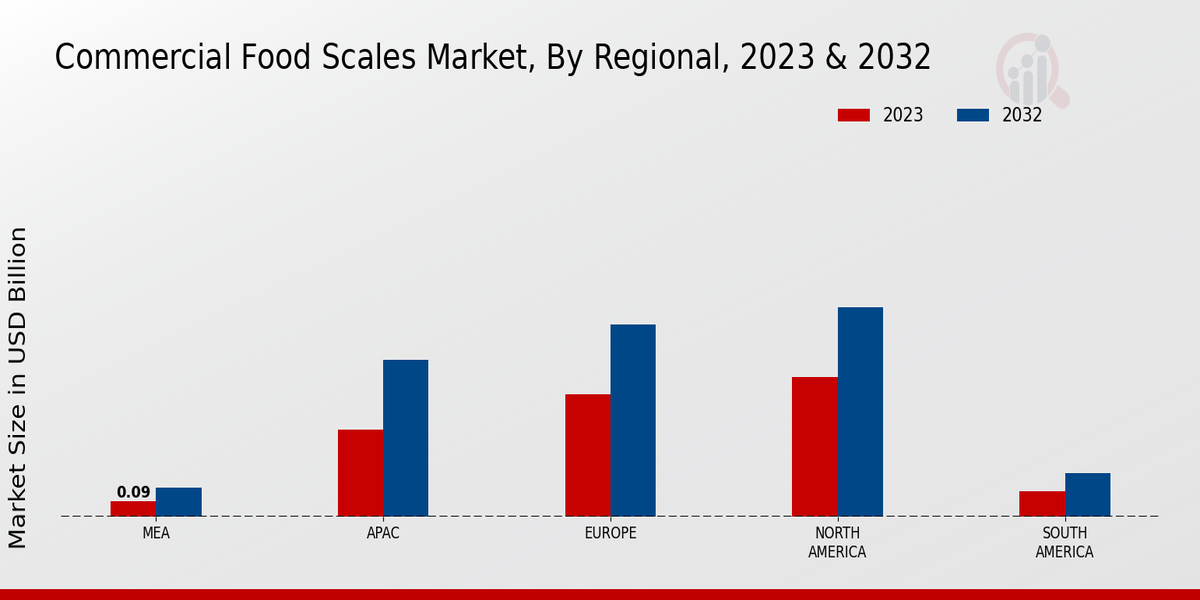Market Growth Projections
The Global Commercial Food Scales Market Industry is on a trajectory of growth, with projections indicating a market size of 2.52 USD Billion in 2024 and an anticipated increase to 4.22 USD Billion by 2035. This growth reflects a compound annual growth rate (CAGR) of 4.81% from 2025 to 2035, driven by various factors including technological advancements, the rise of e-commerce, and an increasing focus on food safety. The market dynamics suggest a robust demand for innovative weighing solutions that cater to the evolving needs of the food service industry.
Focus on Food Safety and Compliance
The Global Commercial Food Scales Market Industry is significantly impacted by the increasing focus on food safety and compliance. Regulatory bodies worldwide are enforcing stricter guidelines regarding food handling and preparation, necessitating accurate weighing solutions. Businesses in the food service sector must adhere to these regulations to avoid penalties and ensure consumer safety. This heightened awareness is driving the demand for reliable commercial food scales that can provide precise measurements. As a result, the market is poised for growth, with projections indicating a rise to 4.22 USD Billion by 2035, as companies prioritize compliance and invest in quality equipment.
Growth of E-commerce in Food Services
The Global Commercial Food Scales Market Industry is significantly influenced by the growth of e-commerce in food services. As online food delivery and meal kit services expand, the need for accurate weighing solutions becomes paramount. E-commerce platforms often require precise measurements for portion control and inventory management, which drives the demand for commercial food scales. This trend is expected to contribute to the market's growth, with projections indicating an increase to 4.22 USD Billion by 2035. The integration of technology in food scales, such as connectivity features for inventory tracking, further supports this growth, aligning with the evolving landscape of food service.
Expansion of the Food Service Industry
The Global Commercial Food Scales Market Industry benefits from the ongoing expansion of the food service industry. As the global population grows and urbanization increases, the demand for diverse food offerings rises. This expansion leads to a greater need for commercial food scales to ensure accurate portioning and inventory management across various food establishments. The market is projected to reach 2.52 USD Billion in 2024, driven by the increasing number of restaurants, catering services, and food processing units. This trend underscores the importance of reliable weighing solutions in meeting the evolving needs of the food service sector.
Rising Demand for Precision in Food Preparation
The Global Commercial Food Scales Market Industry experiences a notable surge in demand for precision in food preparation. As culinary standards elevate, restaurants and food service providers increasingly rely on accurate measurements to ensure consistency and quality. This trend is particularly pronounced in regions with stringent food safety regulations, where precise ingredient measurements are critical. The market is projected to reach 2.52 USD Billion in 2024, reflecting a growing recognition of the importance of accuracy in food service. Consequently, manufacturers are innovating to provide advanced scales that meet these demands, thereby enhancing operational efficiency and customer satisfaction.
Technological Advancements in Weighing Solutions
Technological advancements play a pivotal role in shaping the Global Commercial Food Scales Market Industry. Innovations such as digital displays, connectivity features, and enhanced durability are becoming standard in commercial food scales. These advancements not only improve user experience but also facilitate compliance with food safety regulations. As businesses seek to optimize their operations, the adoption of smart scales that integrate with inventory management systems is likely to increase. This trend is expected to drive the market's compound annual growth rate (CAGR) of 4.81% from 2025 to 2035, as companies invest in modernizing their food preparation processes.





















Leave a Comment